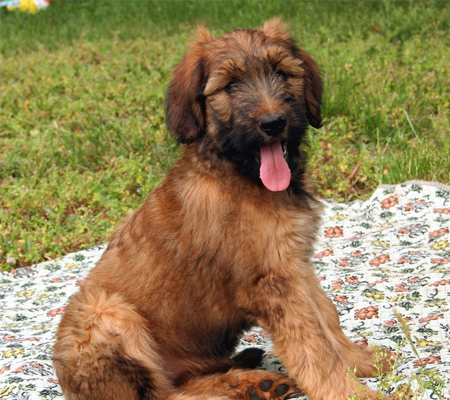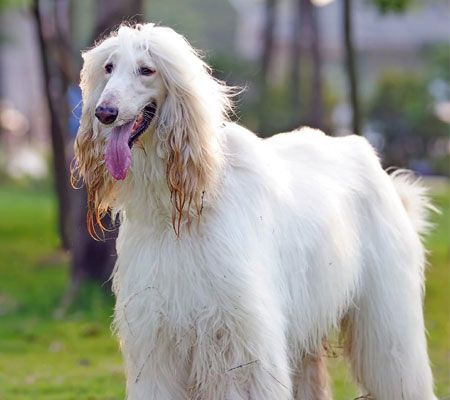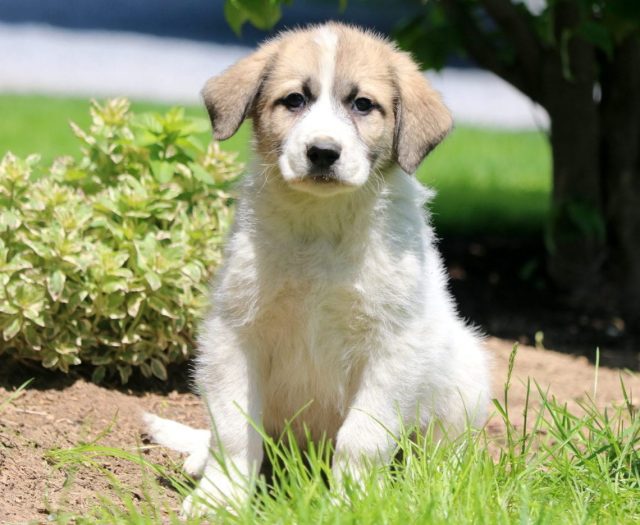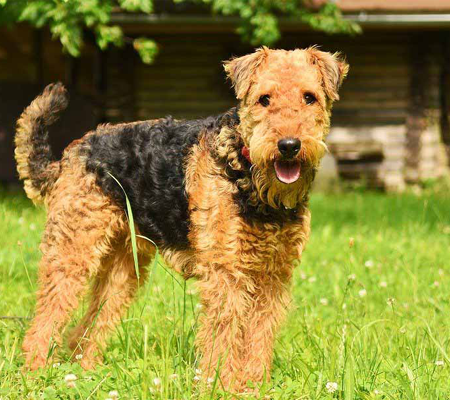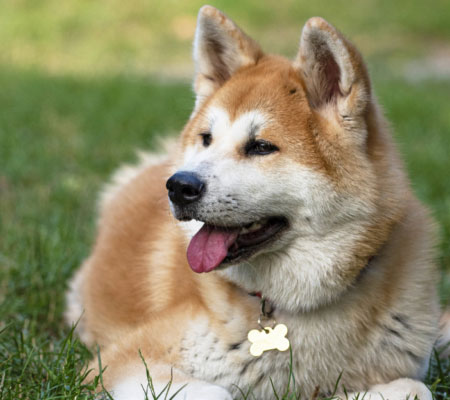The Briard hides a brave temperament and acute
intelligence under his long, shaggy coat. They can be distant with strangers,
yet friendly and caring with their pack mates, as befitting their French
ancestors.
Even though they are purebred canines, they may
end up in shelters or rescue organisations. Keep in mind to adopt! If you want
to bring a dog home, don't go shopping.
Originally bred as herding and guard dogs to
protect flocks and ward off predators, these working dogs were utilised by
troops as sentries, ammo bearers, couriers, and medic dogs during World War I.
Today, the Briard is mostly used as a companion dog, but they have achieved
considerable success in obedience, agility, conformation, herding, carting, and
tracking contests, demonstrating their adaptability and working temperament.
Briard Highlights
Breed Size
Large
Nature
Playful, Friendly
Energy Level
Active
Intelligence
High
Barking Level
When Necessary
Coat Length
Long, Medium
Breed Group
Working
Droll Amount
Low
Good with
Familes, Children, Dog
Feed Level
Medium, High
Colour Type
Black,gray,fawn
Other Facts
Tolerates being alone,cold weather tolerant,strong loyalty tendencies,good hiking companion.
Dog History
The Briard is said to have originated in France
in the 8th century. He was known as the Chien Berger De Brie, which is said to
stem from his birthplace, the Brie area (although the Briard was found in many
parts of France).
There's also a more romantic explanation: the
name is a misspelling of Chien d'Aubry. According to tradition, Aubry de
Montdidier, a courtier of King Charles V, constructed a cathedral in honour of
a brave Briard who saved his son's life in the 14th century.
Regardless of the name's origin, the Briard may
be traced back to Emperor Charlemagne according to early tapestries depicting
him. The Briard was closely associated with Napoleon and served as the French
Army's official breed.
Thomas Jefferson is thought to have brought the
first Briards to America, and the American Kennel Club recognised the breed in
1928. The Briard was not introduced to the United Kingdom until the late 1960s,
which is surprising.
22-27 inch 28-39 kg 10-13 year
Height

Weight

Life Span
Health and Care
Briards are typically healthy, however they are
susceptible to some health issues, as are all breeds. Although not all Briards
will contract any or all of these illnesses, it's vital to be aware of them if
you're thinking about getting one.
Find a reliable breeder who will show you health
clearances for both your dog's parents if you're buying a puppy. Health
clearances demonstrate that a dog has been checked for and cleared of a certain
disease.
You can expect to see health clearances from the
Orthopedic Foundation for Animals (OFA) for hip dysplasia (with a score of fair
or better), elbow dysplasia, hypothyroidism, and von Willebrand's disease in
Briards; thrombopathia from Auburn University; and normal eyes from the Canine
Eye Registry Foundation (CERF) in Briards. The OFA website can be used to
verify health clearances (offa.org).
- Hip Dysplasia
- Elbow Dysplasia
- Congenital Stationary Night Blindness (CSNB)
- Progressive Retinal Atrophy (PRA)
- Von Willebrand's Disease
- Gastric Torsion
Care
The Briard may live in either the city or the
country. When he's indoors, he's a rather quiet breed, but he does require 30
to 60 minutes of daily activity. The Briard can grow bored if there isn't
enough action, which can lead to irritating or harmful habits including
barking, digging, chasing, and chewing. Dog activities, particularly herding
competitions, are a great way for him to burn off steam and refine his innate
herding abilities.
Because the Briard puppy must understand who the
pack leader is or he will want to take over, training should begin as soon as
the puppy arrives home. This does not imply that he should master complex
orders by the age of nine weeks, but he should begin learning good etiquette
and home norms as soon as possible.
Crate training may be a useful tool for
housetraining and keeping your dog safe while you're away, but keep in mind
that while you're at home, he should be with you and not in his crate.
Because the Briard is naturally wary of
individuals who aren't part of his "flock," it's crucial to teach
your Briard puppy to be sociable to strangers. If a Briard is not properly
socialised and taught, he may become aggressive against humans or animals that
he perceives to be a threat.
Dog Breed Care Tips and
Important Instructions
Briards need to exercise on a regular basis. They
like long walks, hiking trails, and swimming, as well as backyard games of
fetch and tug-of-war. Briards excel at obedience, agility, tracking, herding,
and other dog sports as well.
Training is also crucial. These self-sufficient
working canines excel at making decisions on their own and may require some
time to train. Briards, on the other hand, are intelligent animals that can
learn simple orders and new behaviours with a little encouragement and positive
reinforcement—treats don't hurt, either!
"If you're a first-time briard owner, the
dog may occasionally surprise you and do something you didn't train [him], but
that only goes to show how clever they are and how much they want to please
you," Hillier adds.
Maintaining a briard's coat, like training, takes
commitment. When briards are pups, Hillier recommends starting a grooming
programme. Their delicate, fluffy infant coats may not require much care, but
when their rougher adult coats grow in, frequent brushing becomes necessary.
The sooner you begin grooming your briard, the easier it will be to keep up the
routine.
Brush your briard at least once a week to avoid
tangles and eliminate dead hair. During the spring and fall, you may need to
brush them more frequently, although they don't shed much. More good news:
briards don't need to be bathed very often.
"The mature briard coat should be
coarse," Hillier explains, "so it shouldn't need bathing very often
unless [he's] unclean."
Regular nail trims, ear cleanings, and dental
care, such as at-home brushing and professional cleanings, are all part of a
proper grooming routine.
Feeding
3 to 4 cups of high-quality dry food per day,
split into two meals, is the recommended daily quantity.The amount of food your
adult dog consumes is determined by his size, age, build, metabolism, and
degree of activity. Dogs, like people, are unique individuals that require
different amounts of food. It practically goes without saying that a dog that
is very active will require more than a dog who is sedentary. The type of dog
food you buy makes a difference as well; the better the dog food, the more it
will nourish your dog and the less you'll have to shake into his bowl.
Rather than putting food out all the time,
measure his food and feed him twice a day to keep your Briard in good form.
Give him the eye and hands-on tests if you're not sure if he's overweight.
Look down at him first. There should be a waist
visible. Then, with your thumbs down his spine and fingers stretched downward,
place your hands on his back. Without pressing too much, you should be able to
feel but not see his ribs. If you can't, he'll need to eat less and exercise
more.
Fun Facts
- The briard has appeared in a number of films,
including Chuck Norris' Top Dog, Married...with Children, Dennis the Menace,
and Buddy.
- Norman, a briard, holds the world record for a
dog's quickest 30 metres on a scooter. In 2013, he finished the distance in
20.77 seconds.
- Liberty and Justice, two briards, were appointed
the official mascots of Colonial Williamsburg in 2015. They were reenactors
portraying the dogs of George Washington.
Home Training Tips and General
Information
They are easily trained and eager to serve their
master, but they require a strong owner who can guide them. They are incredibly
sensitive to their families' feelings and make good home companions with proper
upbringing.
Briards may require a lot of mental and physical
exertion. They desire to be amused through games and exercises. As owners, you
should do this on a regular basis to help them develop into well-behaved
companion dogs.
They should be socialised as soon as possible,
particularly with youngsters. If they are raised together, they are friendly
and adapt well to living with youngsters. Briards must be taught how to become
pack leaders so that they may understand their role in the pack.
When teaching your Briard puppy, showing
appreciation and providing positive reinforcement is highly beneficial and
necessary.
You should never scream at your young puppy or
punish them for not listening – positive reinforcement is the most effective
way to train your Briard.
Instead than patting your Briard on the top of
their head or back while congratulating them, give them a pat beneath their
chin or chest, which is more loving for them.
Long bouts of training for your Briard are not
recommended. It is more efficient to train them throughout the day with
numerous yet brief sessions. Briards should be trained 3-5 times a day for
5-minute sessions. This guarantees that you have their undivided attention.
Reward your dog with a pet dog treat whenever
they've completed what you've requested of them.
Many Briard owners make the major mistake of
allowing their young puppy to do things that they would not want them to do
later in life (e.g. laying on furniture). Allowing them to develop this habit
will make it incredibly difficult to change your pet dog's behaviour in the
future.
Briard puppy training must begin at the age of
eight weeks, and they normally reach full learning capacity between eight and
twelve weeks.
While complimenting, use a joyful tone; when
saying "No," use a stern tone (but don't yell).
FAQS
|
Is a Briard a decent dog for a family? |
|
The Briard is a wonderful family dog since it is both affectionate and
playful. He is very protective of his family's children, and he has been
known to "defend" them when their parents chastise them. |
|
Is it true that a Briard is a herding dog? |
|
The briard is a member of the herding group and excels in herding and
guarding animals. He's a fun and energetic buddy. |
|
What should I feed my Briard in terms of food? |
|
Every day, Briards consume about three cups of food. This will depend on
his age, size, and degree of energy. Gastric torsion, sometimes known as
bloat, is a recognised affliction of the Briard. |
|
What kind of dog is lurking beneath the surface? |
|
The Kuvasz is a huge, white, Hungary-bred flock-guarding dog. They're a
one-family dog who guards their family and is wary of others. This breed of
dog thinks for itself and can be difficult to teach. |
|
When does a Briard become fully grown? |
|
The Briard is a huge breed that takes roughly 18 months to mature.
Because their bones are still delicate until they are well over a year old,
don't overwork them when they are young. |
Briard Unique Name
| Male Name | Female Name |
|---|---|
| Bo | Betsy |
| Buck | Candy |
| Champ | Duchess |
| Griffin | Fiona |
| Luke | Kali |
| Milo | London |
| Ned | Madison |
| Petey | Maggie |
| Quincy | Matilda |
| Remy | Mia |
| Spike | Noel |
| Thor | Riley |
| Zane | Roxy |
| Bailey | Smokey |
| Banjo | Sunny |
| pencer | Sydney |
| Tanner | Tootsie |
| T-bird | Butterscotch |
| Tiny | Lexus |
| Xena | Tequila |

